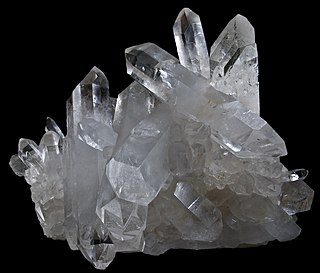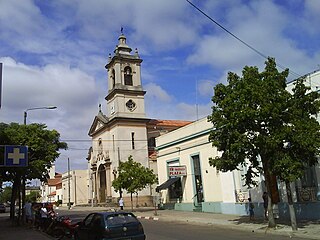Related Research Articles

Amethyst is a violet variety of quartz. The name comes from the Koine Greek αμέθυστος amethystos from α- a-, "not" and μεθύσκω methysko / μεθώ metho, "intoxicate", a reference to the belief that the stone protected its owner from drunkenness. Ancient Greeks wore amethyst and carved drinking vessels from it in the belief that it would prevent intoxication.

Quartz is a hard, crystalline mineral composed of silica (silicon dioxide). The atoms are linked in a continuous framework of SiO4 silicon–oxygen tetrahedra, with each oxygen being shared between two tetrahedra, giving an overall chemical formula of SiO2. Quartz is, therefore, classified structurally as a framework silicate mineral and compositionally as an oxide mineral. Quartz is the second most abundant mineral in Earth's continental crust, behind feldspar.

Sapphire is a precious gemstone, a variety of the mineral corundum, consisting of aluminium oxide (α-Al2O3) with trace amounts of elements such as iron, titanium, cobalt, lead, chromium, vanadium, magnesium, boron, and silicon. The name sapphire is derived via the Latin sapphirus from the Greek sappheiros (σάπφειρος), which referred to lapis lazuli. It is typically blue, but natural "fancy" sapphires also occur in yellow, purple, orange, and green colors; "parti sapphires" show two or more colors. Red corundum stones also occur, but are called rubies rather than sapphires. Pink-colored corundum may be classified either as ruby or sapphire depending on locale. Commonly, natural sapphires are cut and polished into gemstones and worn in jewelry. They also may be created synthetically in laboratories for industrial or decorative purposes in large crystal boules. Because of the remarkable hardness of sapphires – 9 on the Mohs scale (the third hardest mineral, after diamond at 10 and moissanite at 9.5) – sapphires are also used in some non-ornamental applications, such as infrared optical components, high-durability windows, wristwatch crystals and movement bearings, and very thin electronic wafers, which are used as the insulating substrates of special-purpose solid-state electronics such as integrated circuits and GaN-based blue LEDs. Sapphire is the birthstone for September and the gem of the 45th anniversary. A sapphire jubilee occurs after 65 years.

Opal is a hydrated amorphous form of silica (SiO2·nH2O); its water content may range from 3% to 21% by weight, but is usually between 6% and 10%. Due to its amorphous property, it is classified as a mineraloid, unlike crystalline forms of silica, which are considered minerals. It is deposited at a relatively low temperature and may occur in the fissures of almost any kind of rock, being most commonly found with limonite, sandstone, rhyolite, marl, and basalt.

Celestine (the IMA-accepted name) or celestite is a mineral consisting of strontium sulfate (SrSO4). The mineral is named for its occasional delicate blue color. Celestine and the carbonate mineral strontianite are the principal sources of the element strontium, commonly used in fireworks and in various metal alloys.

Crater of Diamonds State Park is a 911-acre (369 ha) Arkansas state park in Pike County, Arkansas, in the United States. The park features a 37.5-acre (15.2-hectare) plowed field, one of the few diamond-bearing site accessible to the public. Diamonds have been discovered in the field continuously since 1906, including the graded-perfect Strawn-Wagner Diamond, found in 1990, and the Uncle Sam, found in 1924, which at over 40 carats is the largest diamond ever found in the United States.

The Royal Ontario Museum (ROM) is a museum of art, world culture and natural history in Toronto, Ontario, Canada. It is one of the largest museums in North America and the largest in Canada. It attracts more than one million visitors every year, making it the most-visited museum in Canada. It is north of Queen's Park, in the University of Toronto district, with its main entrance on Bloor Street West. Museum subway station is named after it and, since a 2008 renovation, is decorated to resemble the ROM's collection at the platform level.

A geode is a geological secondary formation within sedimentary and volcanic rocks. Geodes are hollow, vaguely spherical rocks, in which masses of mineral matter are secluded. The crystals are formed by the filling of vesicles in volcanic and subvolcanic rocks by minerals deposited from hydrothermal fluids; or by the dissolution of syn-genetic concretions and partial filling by the same or other minerals precipitated from water, groundwater, or hydrothermal fluids.

A thunderegg is a nodule-like rock, similar to a filled geode, that is formed within rhyolitic volcanic ash layers. Thundereggs are rough spheres, most about the size of a baseball—though they can range from a little more than a centimeter to over a meter across. They usually contain centres of chalcedony which may have been fractured followed by deposition of agate, jasper or opal, either uniquely or in combination. Also frequently encountered are quartz and gypsum crystals, as well as various other mineral growths and inclusions. Thundereggs usually look like ordinary rocks on the outside, but slicing them in half and polishing them may reveal intricate patterns and colours. A characteristic feature of thundereggs is that the individual beds they come from can vary in appearance, though they can maintain a certain specific identity within them.

The Iranian National Jewels, originally the Iranian Crown Jewels, include elaborate crowns, thirty tiaras, and numerous aigrettes, a dozen bejeweled swords and shields, a number of unset precious gems, numerous plates and other dining services cast in precious metals and encrusted with gems, and several other more unusual items collected or worn by the Persian monarchs from the 16th century and on. The collection is housed at the Treasury of National Jewels, situated inside the Central Bank of Iran on Tehran's Ferdowsi Street.

Artigas is the capital of the Artigas Department of Uruguay. Its name comes from that of the national hero, José Gervasio Artigas, who fought for the emancipation of the River Plate, and sought to create a federative nation from these colonies. As of the census of 2011, it is the eleventh most populous city in the country.
Artigas Department is the northernmost department of Uruguay, located in its northwestern region. Its capital is the city of Artigas, which borders on the Brazilian city of Quaraí. Artigas Department has an area of 11,928 square kilometres (4,605 sq mi), making it the fifth largest in the country. The population is 73,378 inhabitants, according to the 2011 census.

The Denver Museum of Nature & Science is a municipal natural history and science museum in Denver, Colorado. It is a resource for informal science education in the Rocky Mountain region. A variety of exhibitions, programs, and activities help museum visitors learn about the natural history of Colorado, Earth, and the universe. The 716,000-square-foot (66,519 m2) building houses more than one million objects in its collections including natural history and anthropological materials, as well as archival and library resources.

The Hand of Faith is a gold nugget of fine-quality that was found by Kevin Hillier using a metal detector near Kingower, Victoria, Australia on 26 September 1980. Weighing 875 troy ounces, the gold nugget was only 12 inches (30 cm) below the surface, resting in a vertical position. The announcement of the discovery occurred at a press conference, attended by Premier of Victoria Dick Hamer, in Melbourne on 8 October 1980. Kovac's Gems & Minerals was appointed as the agent for the sale of the huge nugget by Hillier. It was sold to the Golden Nugget Casino chain for over a million dollars.

The Napoleon Diamond Necklace is a diamond necklace commissioned by Napoleon I of France c. 1811–1812 from the Parisian jeweler Marie-Étienne Nitot. It is now in the Smithsonian National Museum of Natural History in Washington, D.C.

The Rice Northwest Museum of Rocks and Minerals is a non-profit museum in Hillsboro, Oregon, United States. Located just north of the Sunset Highway on the northern edge of Hillsboro, the earth science museum is in the Portland metropolitan area. Opened in 1997, the museum's collections date to the 1930s with the museum housed in a home built to display the rock and mineral collections of the museum founders. The ranch-style home is listed on the National Register of Historic Places, the first of its kind listed in Oregon. In 2015 the museum became a Smithsonian Affiliate museum.

Nick Cave is an American sculptor, dancer, performance artist, and professor. He is best known for his Soundsuit series: wearable assemblage fabric sculptures that are bright, whimsical, and other-worldly, often made with found objects. He also trained as a dancer with Alvin Ailey and often incorporates dance and performance into his works. His later sculptures have focused on color theory and included mixed media and large-scale installations. He lives in Chicago, Illinois, and directs the graduate fashion program at the School of the Art Institute of Chicago. He continues to work on Soundsuits as well as works completed as a sculptor, dancer, and performance artist.
The Arizona Mining and Mineral Museum in Phoenix, Arizona, was a museum focused on minerals and mining. Last operated by the Arizona Historical Society, a state government agency, its exhibits included more than 3,000 minerals, rocks, fossils, and artifacts related to the mining industry. The museum closed in May 2011. In April 2017, legislation was passed to reopen the museum under the ownership of the University of Arizona.

The Mineral and Lapidary Museum of Henderson County is a non-profit, volunteer-run museum in Hendersonville, North Carolina, United States, founded in 1997 at 400 North Main Street in the middle of the city's Historic District.
The Allison and Roberto Mignone Halls of Gems and Minerals are a series of exhibition halls at the American Museum of Natural History on the Upper West Side in Manhattan, New York City. The halls opened on June 12, 2021, as a complete redesign of their predecessors, the Harry Frank Guggenheim Hall of Gems and Minerals and Morgan Memorial Hall of Gems. The halls feature thousands of rare gems, mineral specimens and pieces of jewelry.
References
- ↑ "Legendary Amethyst - The Empress of Uruguay | EraGem Post Birthstone Series". EraGem Post. February 27, 2019. Retrieved April 23, 2023.
- ↑ "Asombra al mundo la "Emperatriz de Uruguay"" [The "Empress of Uruguay" amazes the world]. El País (in Spanish). June 2, 2016. Retrieved April 23, 2023.